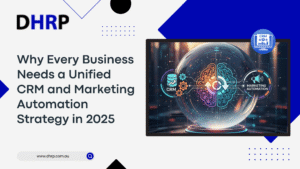Data management is everything in this modern business world.
Organisations are looking for increasingly sorted data to process, better analyse, and make more informed decisions. Traditionally, data from multiple sources, such as CRM, ERP, financial systems, and Microsoft Dynamics 365, is consolidated into a single platform.
However, the data warehousing landscape is changing as cloud-based solutions such as Microsoft Fabric solution gain traction. Traditional data warehousing has long been the foundation of business intelligence (BI) and reporting, but Microsoft Fabric provides a more integrated, scalable, and adaptable approach to data management.
Now, you might wonder how to choose between Cloud-based vs on-premises data warehousing. If your organisation already relies on Microsoft Dynamics 365, integrating with Microsoft Fabric can enhance data accessibility and streamline analytics. We are here to help through this article.
What is a Microsft Fabric Warehouse?
Fabric Data Warehouse is a next-generation data warehousing software built on Microsoft Fabric.Fabric data warehouse, one of the best data warehousing solutions for businesses, is built to natively accept open data formats. Therefore, it allows for easy collaboration between data engineers and business users while maintaining security and governance.
The simple SaaS experience is also intimately connected with Power BI for quick analysis and reporting. It brings the worlds of data lakes and warehouses together and significantly simplifies an organisation’s investment in its analytics estate.
Benefits of Microsoft Fabric Warehouse:
- Data saved in Delta-parquet format supports ACID transactions, and interchange with other Fabric workloads eliminates the need for multiple copies of data.
- Cross-database searches can combine several data sources to provide quick insights with no data duplication.
- Easily consume load and transform data at scale using Pipelines, Dataflows, cross-database queries, or the COPY INTO command.
- Autonomous workload management, combined with an industry-leading distributed query processing engine, means there are no knobs to adjust to get world-class performance.
- Scale almost instantly to suit corporate expectations. Storage and computing are separated.
- Reduced time to insights by using an easily consumable, constantly linked semantic model integrated with Power BI in Direct Lake mode. Reports usually include the most recent data for analysis and reporting.
- One of the major Microsoft Fabric benefits for data management is that it is designed for all skill levels, from citizen developers to DBA or data engineers.
When to Use Microsoft Fabric Warehouse:
- When you require an enterprise-scale solution with an open standard format, no knobs performance, and minimal setup, go with a data warehouse.
- The data warehouse is best suited for semi-structured and structured data formats, and it is appropriate for both novice and experienced data professionals, providing simple and intuitive experiences.
What is Traditional Data Warehousing?
Traditional data warehousing has served as the foundation for business intelligence and enterprise data analytics for decades. It entails the use of organised databases intended to store, organise, and analyse vast amounts of data from multiple sources.
Traditional data warehouses are often installed on-premises or in specific cloud settings. They use Extract, Transform, and Load (ETL) processes to consolidate and clean data before analysis.
Benefits of Traditional Data Warehousing:
- All data from many sources (such as CRM, ERP, and financial systems) is combined into a single platform, assuring consistency and accuracy.
- The ETL process cleans, transforms, and validates data before it is stored, reducing errors and improving data quality.
- SQL-based queries enable firms to generate thorough reports and execute extensive data analysis easily.
- Traditional data warehouses keep historical data, making it easier to spot long-term trends and patterns.
- On-premises data warehouses enable greater control over data security and regulatory compliance because the data is kept within the organisation's infrastructure.
- Data warehouses are designed to handle large-scale queries and data processing without disrupting transactional processes.
- Advanced data visualisation and reporting are made possible by seamless connection with BI tools such as Power BI.
When to Use Traditional Data Warehousing?
- When the majority of the data is in organised formats (such as spreadsheets, CSV files, and relational databases).
- When you need to store and analyse massive amounts of historical data for trend analysis and predictions.
- When your company depends heavily on precise financial, operational, and strategic reports.
- When data quality and consistency are crucial to business choices (for example, in financial reporting).
- When severe security, privacy, and compliance laws must be observed (for example, in the healthcare and financial industries).
- When data volume and query patterns remain consistent and predictable throughout time.
- Traditional data warehouses are useful when real-time data processing is not required, and batch processing is adequate.
Microsoft Fabric vs Traditional Data Warehouse: Which Solution is Right for Your Business?
Factor | Traditional Data Warehousing | Microsoft Fabric |
Deployment | On-premises or cloud-based | Cloud-native (Azure) |
Data Type | Structured data only | Structured + unstructured data |
Scalability | Hardware-dependent | Serverless, auto-scaling |
Integration | Separate tools needed | Unified platform (OneLake) |
Cost | High upfront and maintenance costs | Pay-as-you-go |
Analytics | Basic | AI, ML, real-time insights |
Governance | Manual configuration | Built-in with Microsoft Purview |
Conclusion
When you are uncertain about the choice, just look at the differences, and you can find the right way. Microsoft Fabric is the one if your business needs a more flexible and scalable choice. Need more on it along with the Power BI implementation to get better accuracy with data? DHRP has got you covered. Reach for consultation now.



































































































